Limestone Crusher in Cement Production Line
Limestone is a crucial raw material in the production of cement. It is a sedimentary rock composed primarily of calcium carbonate (CaCO3), making it an essential component for the manufacturing of clinker, the key ingredient in cement. Limestone’s abundance, relatively low cost, and favorable chemical properties make it the primary choice for cement production.
The cement production process involves several stages, and limestone crushing is an essential initial step. Limestone crusher are employed to reduce the size of limestone rocks from their natural quarried dimensions to smaller, more manageable particles. This process is crucial for efficient downstream processing and the production of high-quality cement.

Types of Limestone crusher in Cement Production Line
Two primary types of limestone crusher are commonly used in cement production lines:
- Primary crusher: These crusher handle the initial breakdown of large limestone rocks, typically reducing them to pieces ranging from 6 inches to 3 inches in size. Jaw crusher, gyratory crusher, and impact crusher are common examples of primary crusher.
- Secondary crusher: These crusher further refine the limestone particles from the primary crushing stage, typically reducing them to sizes between 0.25 inches and 2 inches. Cone crusher, hammer crusher, and impact crusher are frequently used as secondary crusher.
The Crushing Process in Cement Production Line
The limestone crushing process in a cement production line typically involves the following steps:
- Feeding: Limestone rocks are initially fed into the crushing plant using conveyors or loaders.
- Primary Crushing: The limestone rocks undergo primary crushing, reducing them to larger, manageable pieces.
- Screening: The partially crushed limestone is then screened to separate particles of the desired size from those requiring further crushing. Oversized particles are returned to the primary crusher.
- Secondary Crushing: The undersized particles from the primary screening stage are directed to secondary crusher for further size reduction.
- Final Screening: The final screening stage separates the crushed limestone into various particle sizes based on specific requirements for downstream processing.
- Transportation: The crushed and screened limestone is then transported to the grinding section of the cement plant for further processing.
Impact of Limestone Crusher on Cement Production
Limestone crusher play a significant role in the cement production process by:
- Enhancing Material Handling: Reducing limestone to smaller sizes facilitates easier transportation and handling throughout the cement production line.
- Improving Grinding Efficiency: Smaller limestone particles are more amenable to grinding, leading to finer raw meal and improved clinker production.
- Optimizing Cement Quality: The uniform particle size distribution achieved by crushing contributes to the production of high-quality cement with consistent properties.
- Reducing Energy Consumption: Efficient crushing processes minimize energy consumption during the size reduction stages, leading to a more sustainable cement production process.
In conclusion, limestone crusher is indispensable components in cement production lines. They transform large limestone rocks into usable particles, enabling efficient downstream processing and the production of high-quality cement. The selection of appropriate crusher types and the optimization of the crushing process are crucial for achieving optimal cement production performance and minimizing environmental impact.









